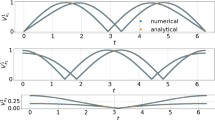Abstract
This paper presents results which characterize the chaotic response of alow-dimensional mechanical oscillator. An experimental system based on acart rolling on a two-well potential surface has been shown to closelyapproximate a modified form of Duffing's equation. Two-frequency forcingis applied, providing a useful means of varying the dimension of theresponse. Computation of correlation dimension and Lyapunov spectra areperformed on both experimental and numerical data in order to assess theutility of these measures in a practical setting. A specific focus isthe distinction between subharmonic and quasi-periodic forcing, sincethis has a subtle, and interesting, effect on the subsequent dynamics.The results tend to highlight the statistical nature of the measures andthe caution that should be used in their interpretation.
Similar content being viewed by others
References
Virgin, L. N., Introduction to Experimental Nonlinear Dynamics: A Case in Study Mechanical Vibration, Cambridge University Press, Cambridge, 2000.
Wiggins, S., ‘Chaos in the quasiperiodically forced Duffing oscillator’, Physics Letters A 124(3), 1987, 138–142.
Heagy, J. and Ditto, W. L., ‘Dynamics of a two-frequency parametrically driven Duffing oscillator’, Journal of Nonlinear Science 1, 1991, 423–455.
Rao, S. S., Mechanical Vibrations, Addison-Wesley, Reading, MA, 1995.
Takens, F., ‘Detecting strange attractors in turbulence’, in Dynamical Systems and Turbulence, D. A. Rand and L.-S. Young (eds.), Lecture Notes in Mathematics, Vol. 898, Springer-Verlag, New York, 1981, pp. 366–381.
Abarbanel, H. D. I., Brown, R., Sidorowich, J. J., and Tsimring, L. S., ‘The analysis of observed chaotic data in physical systems’, Reviews of Modern Physics 65(4), 1993, 1331–1392.
Fraser, A. M. and Swinney, H. L., ‘Independent coordinates for strange attractors from mutual information’, Physical Review A 33, 1986, 1134–1140.
Sauer, T., Yorke, J. A., and Casdagli, M., ‘Embedology’, Journal of Statistical Physics 65, 1991, 579.
Kantz, H. and Schreiber, T., Nonlinear Time Series Analysis, Cambridge University Press, Cambridge, 1999.
Abarbanel, H. D. I., Analysis of Observed Chaotic Data, Springer-Verlag, New York, 1996.
Brown, R., ‘Using near neighbors to determine embedding dimension for phase space reconstruction’, in Proceedings of the 1st Experimental Chaos Conference, S. Vohra, M. Spano, M. Shlesinger, L. Pecora, and W. Ditto (eds.), World Scientific, Singapore, 1981, pp. 24–30.
Kennel, M. B., Brown, R., and Abarbanel, H. D. I., ‘Determining embedding dimension for phase-space reconstruction using a geometrical construction’, Physical Review A 45(6), 1992, 3403–3411.
Broomhead, D. S. and King, G. P., ‘Extracting qualitative dynamics from experimental data’, Physica D 20, 1986, 217–236.
Banbrook, M., Ushaw, G., and McLaughlin, S., ‘How to extract Lyapunov exponents from short and noisy time series’, IEEE Transactions on Signal Processing 45(5), 1997, 1378–1382.
Kruel, T.-M., Freund, A., and Schneider, F. W., ‘The effect of interactive noise on the driven Brusselator model’, Journal of Chemical Physics 93(1), 1990, 416–427.
Grassberger, P., Schreiber, T., and Schaffrath, C., ‘Nonlinear time sequence analysis’, International Journal of Bifurcation and Chaos 1(3), 1991, 521–547.
Abarbanel, H. D. I. and Kennel, M., ‘Local false nearest neighbors and dynamical dimensions from observed chaotic data’, Physical Review E 47, 1993, 3057–3068.
Williams, G. P., Chaos Theory Tamed, Joseph Henry Press, Washington, DC, 1997.
Grassberger, P. and Proccacia, I., ‘Measuring the strangeness of strange attractors’, Physica D 9, 1983, 189.
Grassberger, P. and Proccacia, I., ‘On the characterization of strange attractors’, Physical Review Letters 50(5), 1983, 346–349.
Albano, A., Mees, A., de Guzman, G., and Rapp, P. E., ‘Data requirements for reliable estimation of correlation dimensions’, in Chaos in Biological Systems, H. Degn, A. V. Holden, and L. F. Isen (eds.), Plenum, New York, 1987, pp. 207–220.
Smith, L. A., ‘Intrinsic limits on dimension calculations’, Physics Letters A 133, 1988, 283.
Nerenberg, M. and C. Essex, C., ‘Correlation dimension and systematic geometric effects’, Physical Review A 42, 1990, 7065–7074.
Ruelle, D., ‘Deterministic chaos: The science and the fiction’, Proceedings of the Royal Society of London A 427, 1990, 241–248.
Theiler, J., ‘Spurious dimension from correlation algorithms applied to limited time-series data’, Physical Review A 34, 1986, 2427.
Grassberger, P., ‘An optimized box-assisted algorithm for fractal dimensions’, Physics Letters A 148, 1990, 63–68.
Jedynak, A., Bach, M., and Timmer, J., ‘Failure of dimension analysis in a simple five dimensional system’, 1770–1780.
Theiler, J., ‘Estimating fractal dimension’, Journal of the Optical Society of America 7(6), 1990, 1055–1073.
Moon, F. C., Chaotic and Fractal Dynamics: An Introduction for Applied Scientists and Engineers, Wiley, New York, 1992.
Wolf, A., Swift, J., Swinney, H., and Vastano, J., ‘Determining Lyapunov exponents from a time series’, Physica D 16, 1984, 285–317.
Peitgen, H.-O., Jürgens, H., and Saupe, D., Chaos and Fractals: New Frontiers of Science, Springer-Verlag, New York, 1992.
Darbyshire, A. G. and Broomhead, D. S., ‘Robust estimation of tangent maps and Liapunov spectra’, Physica D 89, 1996, 287–307.
Eckmann, J.-P., Kamphorst, S., Ruelle, D., and Ciliberto, S., ‘Liapunov exponents from time series’, Physical Review A 34(6), 1986, 4971–4979.
Brown, R., Bryant, P., and Abarbanel, H. D. I., ‘Computing the Lyapunov spectrum of a dynamical system from an observed time series’, Physical Review A 43, 1991, 2787–2806.
Bryant, P., ‘Computation of Lyapunov exponents from experimental data’, in Proceedings of the 1st Experimental Chaos Conference, S. Vohra, M. Spano, M. Shlesinger, L. Pecora, and W. Ditto (eds.), World Scientific, Singapore, 1981, pp. 11–23.
Shin, K. and Hammond, J.-K., ‘The instantaneous Lyapunov exponent and its application to chaotic dynamical systems’, Journal of Sound and Vibration 218, 1998, 389–403.
Gottwald, J. A., Virgin, L. N., and Dowell, E. H., ‘Experimental mimicry of Duffing's equation’, Journal of Sound and Vibration 158, 1992, 447–467.
Author information
Authors and Affiliations
Rights and permissions
About this article
Cite this article
Nichols, J.M., Virgin, L.N. Practical Evaluation of Invariant Measures for the Chaotic Response of a Two-Frequency Excited Mechanical Oscillator. Nonlinear Dynamics 26, 67–86 (2001). https://doi.org/10.1023/A:1012923517945
Issue Date:
DOI: https://doi.org/10.1023/A:1012923517945




